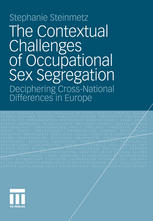

Most ebook files are in PDF format, so you can easily read them using various software such as Foxit Reader or directly on the Google Chrome browser.
Some ebook files are released by publishers in other formats such as .awz, .mobi, .epub, .fb2, etc. You may need to install specific software to read these formats on mobile/PC, such as Calibre.
Please read the tutorial at this link: https://ebookbell.com/faq
We offer FREE conversion to the popular formats you request; however, this may take some time. Therefore, right after payment, please email us, and we will try to provide the service as quickly as possible.
For some exceptional file formats or broken links (if any), please refrain from opening any disputes. Instead, email us first, and we will try to assist within a maximum of 6 hours.
EbookBell Team

4.0
36 reviewsThis study untangles the complex interplay of individual and contextual factors shaping cross-national differences in horizontal and vertical occupational sex segregation. It relates the individual factors affecting occupational decisions to the broader social and economic context within a given society. Following this approach, Stephanie Steinmetz provides a comprehensive overview of the development and causes of cross-national differences in occupational sex segregation. She offers insights into the positioning of 21 EU Members States, particularly of former CCE countries. Based on advanced multi-level models, the study shows that institutional factors, such as the organization of educational systems, post-industrial developments, social policies, and the national ‘gender culture’, play a crucial role in shaping sex segregation processes apart from individual factors. The author clarifies that a distinct set of institutional factors is relevant to each of the two dimensions of occupational sex segregation and that these factors operate in different directions: some reduce horizontal segregation while at the same time aggravating the vertical aspect. Finally, the study assesses the empirical findings from a political perspective by addressing the future contextual challenges of EU Member States seeking to attain higher gender equality on the labour market.